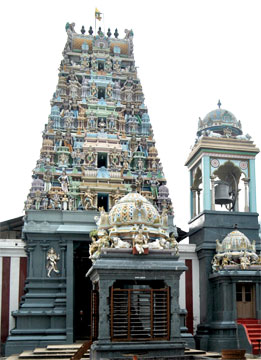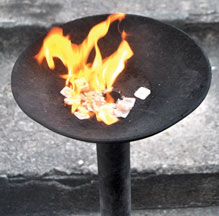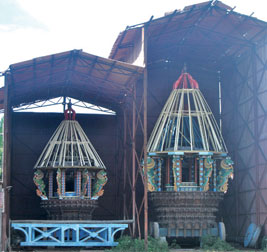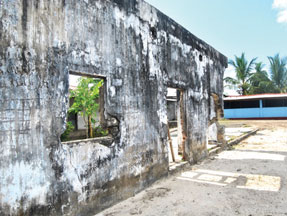|
Where devotees worship daily:
Thiruketheeswaram Kovil

The harsh rays of the burning sun reached every inch of the Kovil
premises. It was three in the evening and the place was deserted except
for Murali, the boy who was clearing the yard and us. The daily pooja
was at five and we had plenty of time to walk around the place.
Thiruketheeswaram Kovil, one of the five main Hindu temples of the
country dedicated to God Siva, is an ancient Hindu Kovil situated in
Manthei. It is about seven miles to the North from Mannar Town.
As the legend unfolds Kethu Bhagavan worshipped Lord Siva at this
temple, and that is how the temple got its name Thiruketheeswaram.
This Kovil is one of the main places of worship sights in Mannar.
Many Hindus and non-Hindus from all over the country visit this place
nearly every day. “We never had to do the evening pooja without
devotees. All around the year people visit this Kovil,” said Swami
Nithyanandan. “The place is blessed with people,” he added.
The history of the temple goes back to the era of Chola. It is
believed to be built in 600 B.C. Another story related to the Kovil says
that the father-in-law of Ravana, the king of Lanka, built
Thiruketheeswaram. Ravana himself had been a devotee of Koneswaram
Temple, Trincomalee. Rama, who built the Sivan Temple at Rameshwaram, on
his way back to Ayodhya from Lanka, is reputed to have worshipped Lord
Siva at the Thiruketheeswaram as well.
 |
|
The Thiruketheeswaram
Temple |
The Assistant Archaeology Commissioner, S. Sanmuganathan, in his
research paper ‘Excavations at Thiruketheeswaram’ states that ,”The
ancient Saiva shrine of Mahathiththa called Thiruketheeswaram is
referred to in Tamil devotional hymns dating from 7th century A.D.”
However, the invasion of the Portuguese Catholic colonists in 1505
brought the darkest period of the Kovil. They destroyed the buildings
and took most of the valuable items in it.
The materials found from the Kovil and from the nearby Buddhist
temples were used to build the Fort of Mannar. One of the most popular
Tamil civil servants, Sir Kanthiah Vaithianathan explains this tragedy
plainly in his report named ‘Thiruketheeswaram temple and the port of
Manthota’, “To the Portuguese who had set about to plunder the rich
Hindu Temples of the Deccan, Thiruketheeswaram was even an easier pray
than Kanya Kumari, which they succeeded in plundering.
The conversation of the people of Mannar Island was preceded by the
plunder of Thiruketheeswaram, whose very stones were subsequently used
in the construction of the Mannar Fort.
The feeble effort made by the king of Jaffna to avenge the crime on
Thiruketheeswaram was magnified into a massacre.” He also added in this
report that the good and the bad times of the Kovil were directly
related to the political condition of the country.
The Kovil prospered during the period of Cholas and Pandyans. Even
Parakramabahu the Great had been having a soft corner for the Kovil. It
is evident from the ruins found from the site that the Kovil was once
built according to Pandyan architectural style. The exact location of
the destroyed temple was located more or less after 400 years in 1894.
In the 20th century most of the restorations of the Kovil was
completed. In June 1903, a small temple was reconstructed and the
central shrine was reconstructed and re-consecrated in 1921.

 |
|
A statue of a rat |
The Kovil has gone through several facelifts and additions until
1970’s and the tank near the Kovil, Palavi tank, was rebuilt in 1949.
The Palavi tank is prospered by the river Palavi, which had been the
outlet of Matale waters via Malwattu Oya and other natural waterways of
the extensive basin.
Presently the devotees are advised to bathe from this tank without
using the main pipeline, since the water supply to the Kovil is only
twice a day for two hours. At present, the Thiruketheeswaram restoration
committee does the management of the Kovil. The main priest of the Kovil
is Swami Shiva Kumar who had served the temple for 35 years. He had seen
vicissitudes of the temple since 1976. For him, the most haunting time
at the Kovil is the period of the recent war.
“The Kovil was closed for 12 long years. We fled from the place to
secure our selves. No one was here during that period,” he said. The
temple was reopened in 2002 during the ceasefire agreement of the two
parties.
Though the Kovil was untouched during the war, around 24 ‘madams’ or
rest houses, situated around the place for the use of the devotees, were
destroyed.
“Two parties had fired each other by covering themselves from these
buildings. Only a few walls remained intact,” said one of the caretakers
of the Kovil who had come here in 2002. When asked about his experience
of the war he said with a smile, “After I arrived there were no face to
face gun fires. All came from above,” Though it sounded a tragedy the
way it was replied brought us a good laugh.
 |
|
Wooden cart under
construction |
 |
|
Destroyed rest house of
the Kovil |
Now the Kovil has a new rest house and used by the devotees who come
from faraway places. “Even yesterday there were people from Kottawa and
Rajagiriya,” he added.
The festival of the Thiruketheeswaram Kovil is held annually in May.
This year it starts on May 8, and finishes on Vesak Poya day. A huge
wood cart decorated by excellent carvings, and which was restored
recently is used for the procession. Along with that a statue of a rat,
bull and a peacock will be paraded.
Inside the main temple, there are shrines of Nadarajar, Vineyakar,
Somaskander, Maha Vishnu, and a Maha Lakshmi Shrine along with the Maha
lingam. The main entrance of the Kovil is decorated with a tree storied
Raja Gopuram.
The area where the Maha Mandapam is situated was decorated from
magnificent stone carvings.
In addition, there were two decorated outlets from the main shrine in
the shape of a dragonhead, to remove water or milk from the inside
chamber.
There were few peacocks roaming around the premises, which doubled
the beauty of the place.
Pix: Janani Amarasekara
|

